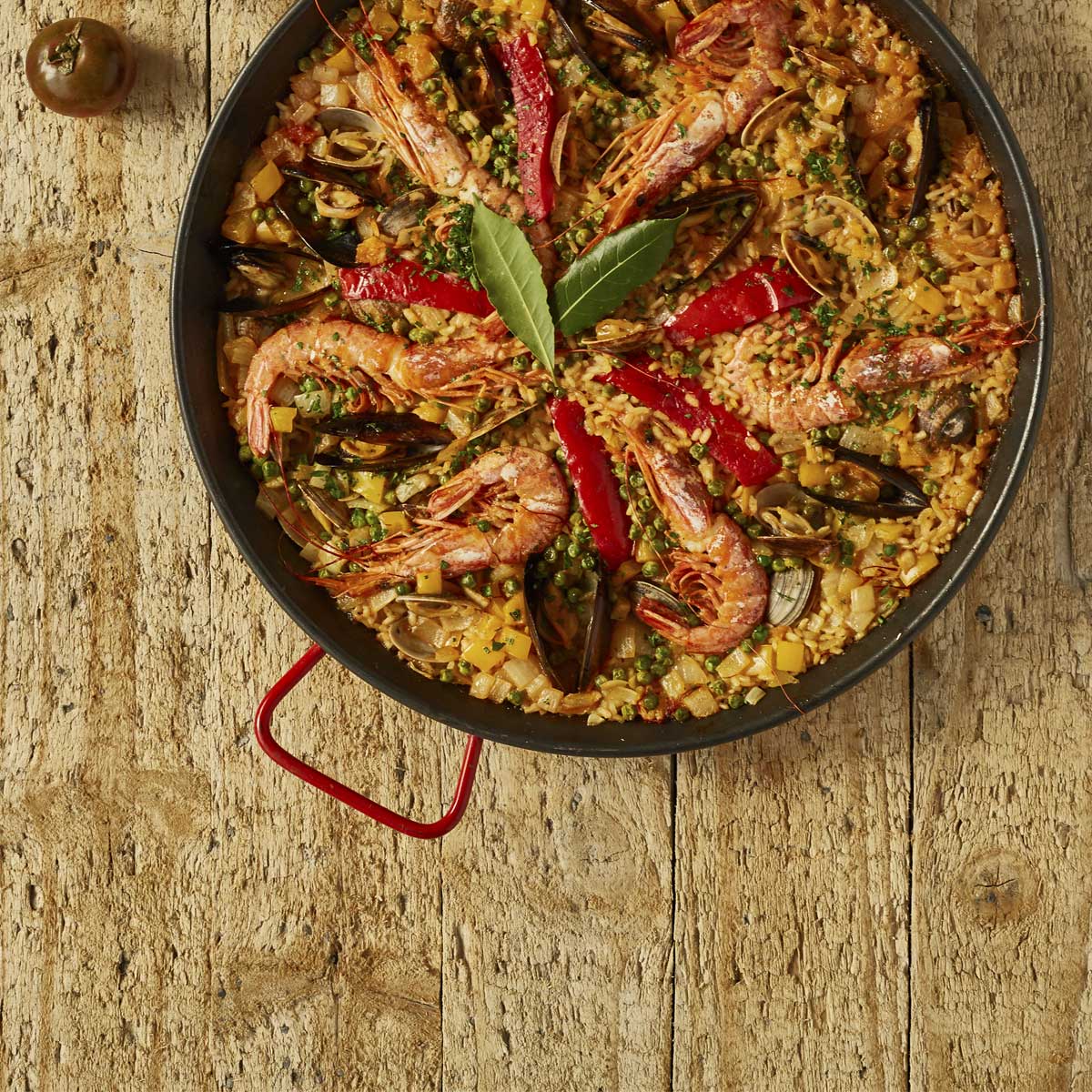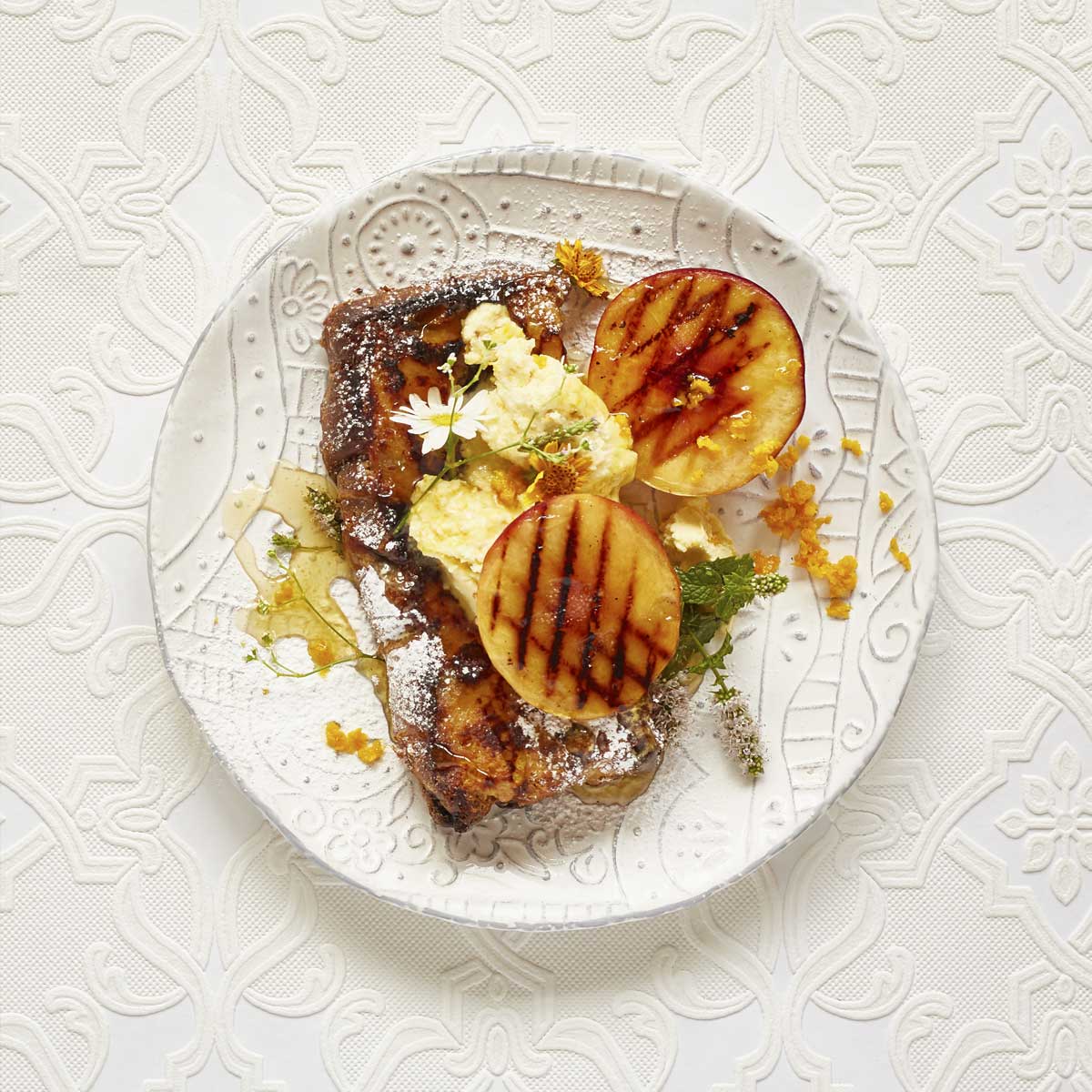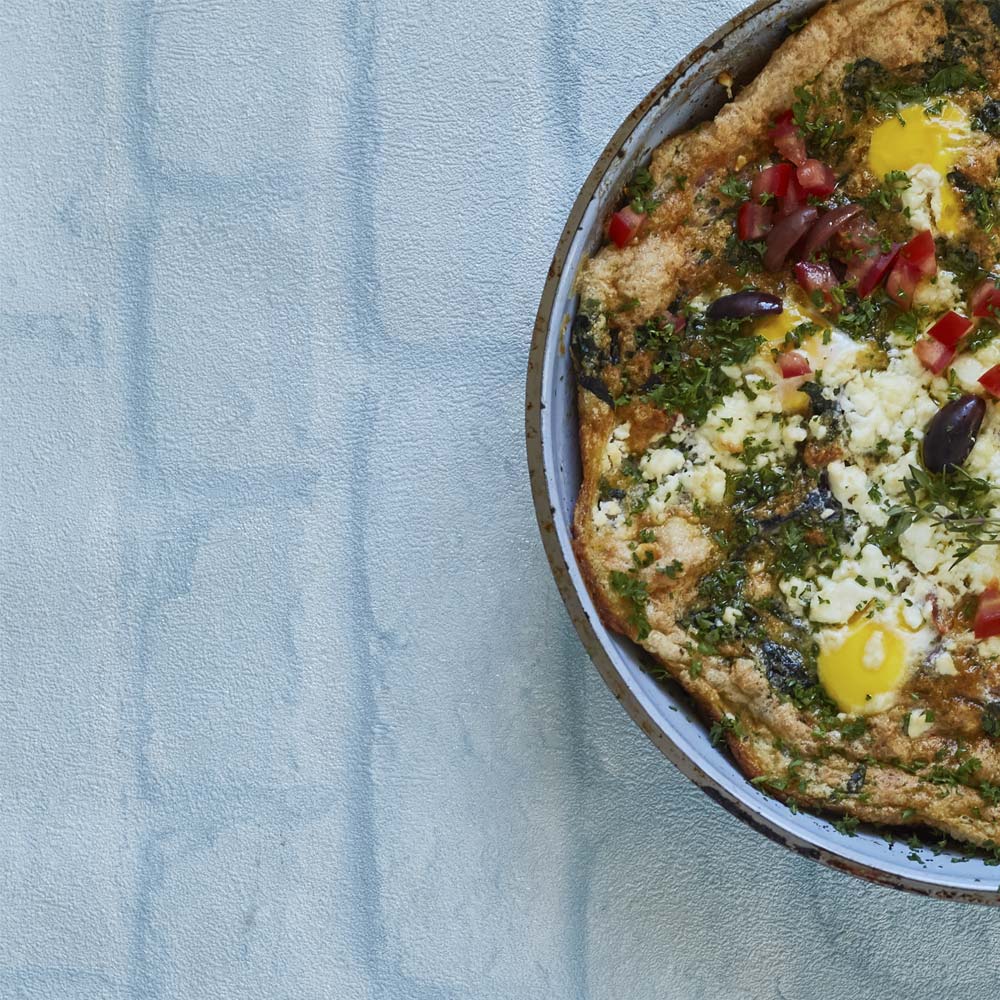Recipes
Seafood Paella
Albufera, in Valencia, is known as the birthplace of Paella. On the outskirts of Madrid sits the award winning restaurant L’Albufera where Alix received personal tutelage from the Paella master himself – Julian Garcia.

Spain
Seafood Paella

Ingredients
10 Cloves Garlic
45ml Fresh Chopped Parsley
60ml Olive Oil
60ml Water
250g Diced Calamari
250g Mixed Seafood (Mussels, Clams, Shrimp, Scallops)
2 Ltrs Stock – Seafood or Chicken
5ml Saffron Threads1 Medium Onion – finely diced
1 Red Pepper – seeded & diced
750ml Bomba Paella Rice
15ml Sweet Paprika
125ml Pureéd Tomatoes
125ml White Wine or Beer
12 Large Prawns or Langoustines – de-veined
12 Mussels in the Shells
125ml Clams in the shell
125ml Frozen Baby Peas
Lemon Wedges for Garnishing
Method
Preheat the oven to 200 degrees celsius. Place a roasting dish 3/4 full of water on the bottom shelf of the oven.
To make the marinade pulse the garlic, parsley, olive oil and water in a blender until well mixed, but still slightly chunky. Marinate the diced calamari and seafood in 45 ml for 5 minutes.
Warm the stock in a saucepan over medium heat, adding the saffron.
Toss the onion and red pepper in 45ml of the marinade and set aside for 5–10 minutes.
Heat a 6 – 8 serving paellera over medium heat and sauté the marinated onions and red peppers for 2-3 minutes until they begin to be translucent. Add the marinated seafood and sauce, and cook for a further 2-3 minutes. Add an additional 30 ml of the marinade, plus the rice, paprika and tomatoes. Stir well. Pour in the wine or beer and simmer for 2-3 mins. Now add half the stock, stirring until the rice has absorbed some of the liquid. This usually takes roughly 2-3 minutes.
Place the prawns, mussels, clams and peas on top of the rice. Pour over the remaining stock and simmer until almost all of the liquid has been absorbed. Place the pan in the oven and cook for an additional 10–12 minutes until the remaining liquid has been absorbed, but the rice is still al dente.
Drizzle over the remaining marinade and garnish with fresh parsley and lemon wedges.
Serve with Alioli
Italy
Panettone French
toast with marscarpone & grilled peaches
Ingredients
6 thick slices Panettone
Challah or Brioche
4 eggs
250ml milk
250ml fresh cream
1 vanilla pod (seeds scraped out or 10ml vanilla essence)
Pinch of salt
Zest & juice of 1 orange
60ml clarified butter
20ml brown sugar,
preferably Demerara
3 peaches halved
250g tub mascarpone
Icing sugar for dusting
Method
Lay the slices of bread in a large baking dish.
Blend the eggs, milk, cream, vanilla, salt, orange juice and zest in a blender, or with a stick blender, until foamy. Pour the mixture over the bread and cover with plastic wrap. Leave in the fridge for a few hours, but preferably overnight.
Preheat the oven to 180 degrees celsius. Place a tray in the over while it heats up.
Take the pieces of bread out of the fridge, brush with 30 ml of the butter and sprinkle with 15 ml of the sugar. Flip the bread over and brush the other side with butter. Remove the hot tray from the oven, spray lightly with cooking spray, and place the slices, with the sugared side on top, into the tray. Return to the oven and bake for 20-30 minutes, flipping occasionally until golden brown and crispy on the outside and custardy on the inside.
Heat a cast-iron grill pan over medium heat and grill the peaches cut side down, until nicely scored. Turn the peaches 90 degress and continue grilling until they are charred with a crisscross pattern.
Whisk the remaining 5 ml of sugar into the mascarpone.
Serve the french toast with half a grilled peach, a dollop pf mascarpone and a dusting of icing sugar.

Greece
Breakfast in Mykonos
On a Sunday morning, I was staring out of my galley window, searching for inspiration for that morning’s breakfast special. The style of the condominiums cascading down the cliffs reminded me of the architecture of the Cyclades in Greece. I decided to bake eggs in a nest of key Greek ingredients and so Breakfast in Mykonos was born. It became the instant favourite of my then boss, it was also the last breakfast I cooked the day I left the yachting industry.

Ingredients
200g baby spinach, roughly chopped
3 tomatoes, seeded & diced
1 small red onion, finely sliced
12 Kalamata olives, pitted and sliced
60ml olive oil
Zest and juice of 1 lemon
5ml dried origanum
Pinch of salt
Freshly ground black pepper
50ml melted butter
100ml double cream
6 eggs, separated
100g feta cheese, crumbled
15ml chopped fresh parsley for garnishing
Method
Put the spinach, tomatoes, onion, olives and olive oil in a bowl and mix well. Add the lemon juice, zest, origanum, salt and pepper, mix again and set aside for 30 minutes for the flavours to infuse.
Preheat the oven to 200°C. Put a large baking dish or cast-iron pan in the oven to heat up while the oven is coming up to temperature. Alternatively, if you’d like to make individual portions, place six ramekins on a baking tray. Whisk the butter and cream together.
Take the baking dish out of the oven and pour the cream mixture into it. Place back in the oven for 5-8 minutes or until the mixture starts to bubble.
Beat the egg whites until foamy and pour them into the bowl with the vegetables. Combine gently. Remove the baking dish from the oven and pour the egg white mixture into it.
Using a tablespoon, make six little holes in the mixture and carefully place a yolk in each one. Sprinkle with feta cheese and return to the oven to bake for 5-8 minutes or until the egg whites are starting to set. (If you prefer the yolks to be set too, leave in the oven for a while longer.)
Turn on the grill and allow the feta to char slightly. Remove from the oven, sprinkle with fresh parsley and black pepper. Serve with crusty bread or pitas for mopping up the golden yolks.
Spain
Ensaïmada
Method
Dissolve the yeast in the milk with 15 ml of the sugar and set aside until foamy.
Put half of the flour into a large mixing bowl, or the bowl of a stand mixer with the dough hook attached. Pour in the yeast mixture and incorporate thoroughly until the ingredients form a dough. Cover the bowl with plastic wrap and leave in a warm place for 30-40 minutes until the dough has doubled in size.
While the dough is rising, remove the eggs from the fridge and allow to come to room temperature. Add the eggs, one at a time, to the dough along with the rest of the sugar, flour, salt and half of the saïm. Knead for 5-7 minutes. Cover with plastic wrap and leave in a warm place for 30-40 minutes until the dough has doubled in size.
Turn the dough out onto a lightly floured work surface, knead for 2-3 minutes and roll out as thin as possible using a rolling pin. Brush the surface of the dough with the rest of the saïm or butter and roll up as tightly as possible. Leave to rest for an hour.
After the dough has further risen, coil it into a spiral and placed on a greased baking tray. Cover with a bucket or large bowl, something that won’t stick to the dough when it rises. Allow to rise for 2-3 hours or overnight.
Preheat the oven to 190 degrees celsius. Bake for 30-40 minutes, until the top is golden brown. Remove from the oven and brush with melted butter and dust libeerally with icing sugar. Serve at room temperature. They can also be sliced horizontally and spread with jam, chocolate spread or pastry cream.
